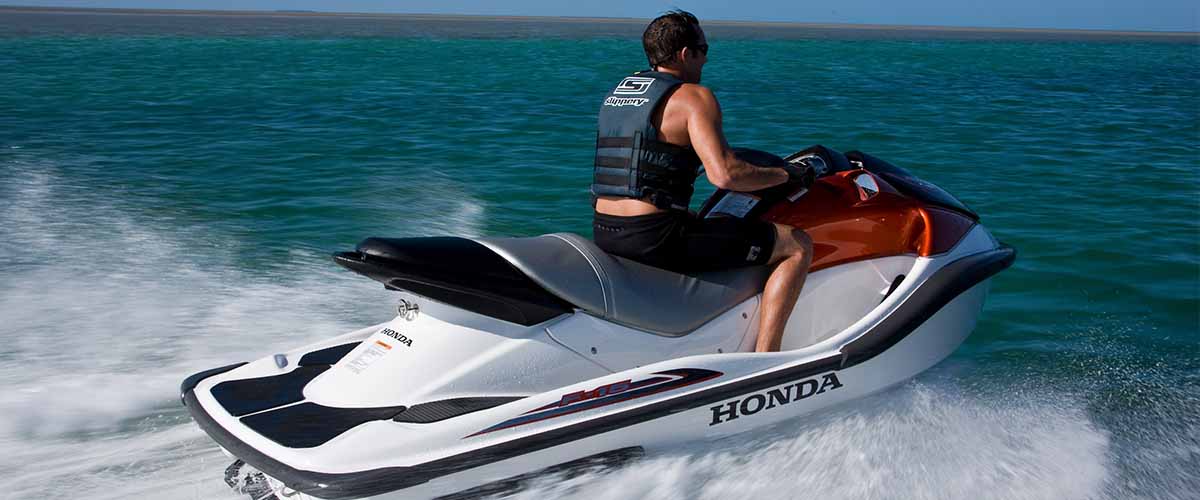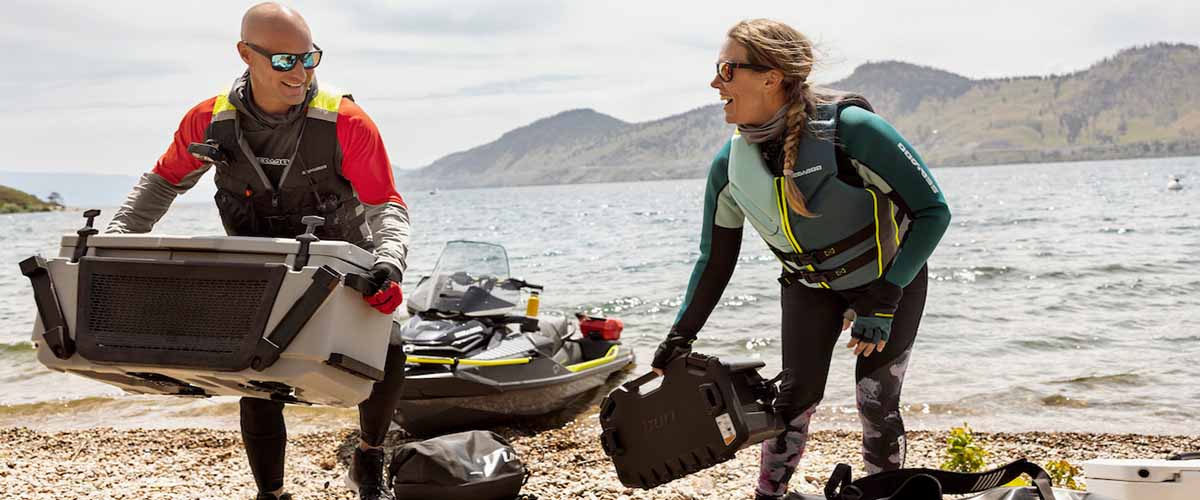1995-1997 Kawasaki 750 STS Review and Specs [Video]
The Kawasaki STS (a.k.a. 750 STS) was a 2-stroke 3-seater Jet Ski, released as the successor of the underpowered 750ST. These skis shared the same hull and top deck, but the STS came standard with gauges, dual mirrors, and a more powerful, dual-carb engine. It was phased out by the more advanced 750 STX in 1998.
If you want to find out more about this popular 2-stroke 3-seater Jet Ski, this post is for you.
We at JetDrift have compiled all you need to know into this Kawasaki 750 STS review!
1995-1997 Kawasaki 750 STS Review
Kawasaki 750 STS Hull and Top Deck
Kawasaki released the 3-seater STS in 1995, as a more advanced configuration of the 750ST. The latter remained in production during 1995 but was discontinued for the following season.
The official name of the new model was simply “Kawasaki STS,” but it was more commonly known as 750 STS or STS 750, referring to its 750 engine.
The STS inherited its platform from its predecessor, and measured 122 inches in length, 46.5 inches in width, and 39 inches in height. Compared to the 2-seater (SS) Kawasaki Jet Ski family, this shell was 5.9 inches wider, 22.4 inches longer, and much heavier.
The top deck of the STS was equipped with dual mirrors and a dashboard mounted on the steering handlebar cover.
This dashboard was borrowed from the Super Sport Xi and housed a trim indicator gauge, a standard analog tachometer, and a Kawasaki logo. As the name suggests, the trim indicator gauge showed the vertical position of the jet pump nozzle in trimming the jet ski, while the tachometer showed the engine speed in the number of revolutions per minute.
Apart from these upgrades and the new purple/blue color scheme, the deck was carried over from the ST without any significant changes.
The 750 STS featured a roomy 3-rider seat, standard bow storage, a rear storage pocket, a glovebox, and a 12.2-gallon fuel tank.
The dry weight of the ‘95 750 STS was 551 pounds, which climbed up to 567 pounds for the next model year.
Kawasaki 750 STS Engine and Propulsion
The power source of the Kawasaki 750 STS was a 2-stroke, 743cc, dual-carb, “big-pin” vertical twin Kawasaki Jet Ski engine. In terms of engine power, the 1995 750 STS (JT750-B1) was rated at 80 HP while the more advanced ’96-’97 750 STS (JT750-B2) produced 83 HP thanks to some minor performance upgrades.
This was a huge improvement over the single-carb 750ST which delivered only 63 HP!
The key features of the dual-carb 750 STS engine were as follows:
- 2-stroke, vertical twin architecture
- “Bin-pin” engine configuration: ported for high-speed performance
- Dual Keihin CDK 40-31 carburetors
- NGK BR8ES spark plugs
- Crankcase reed valve configuration
- Oil injection system
- Magneto CDI ignition system
- Open-loop cooling system
- Electric starter
Thanks to its powerful big-pin, twin-carb engine, the 750 STS wasn’t as underpowered as its predecessor. It could get on place fairly easily and topped out at 48 mph.
What’s more, its engine was far more durable and dependable.
The propulsion system of the 750 STS was an axial-flow, single-stage jet pump. The claimed performance of this pump was 655 pounds on the ’95 model, which jumped up to 668 pounds for the ’96-’97 models.
Due to this power increase, the fuel consumption of the ski also increased from 8.5 GPH to 9.5 GPH.
Its smaller brother was the ’95-’96 750ZXi, which utilized the same engine and pump but was built on a smaller and lighter platform.
Kawasaki 750 STS Features
The 750 STS came standard with many innovative features, including:
- Manual reverse system
- Dashboard with tachometer and trim gauge
- Display panel with oil and fuel level warning lights, fuel indicator lights, and an engine overheating warning light
- Choke knob
- Fuel knob
- Adjustable trim
- Handlebar-mounted start/stop buttons
- Shut-off switch with safety lanyard
- Front storage compartment
- Fire extinguisher compartment
- Rear storage pocket
- Glovebox
- Tool kit
- Drain plugs
- Finger throttle lever with throttle limiter
- Dual mirrors
- Tow hook
- Mooring cleats
- Rear grab handle
- Sponsons
- Underwater exhaust outlet
- Deck mats
The key improvements of the STS over the 750ST were as follows:
- Big pin, dual-carb engine
- Mirrors
- Dashboard
- Finger throttle
Kawasaki marketed the 750 STS from 1995 through 1997 when it was phased out by the more advanced 750STX.
1998 Kawasaki 750 STX Review
The Kawasaki 750 STX was virtually a rebranded 750 STS, introduced as the last 750cc 3-seater Kawasaki Jet Ski.
This model inherited its engine and hull from the 750 STS while its top deck had some slight upgrades. Its design was fresh with red/grey decals while the body remained white.
The 750 SXT was only marketed in 1998, as the smallest brother of the popular STX family. This series included the more powerful, 3-cylinder 900 STX and 1100 STX.
Kawasaki 750 STS Specs Charts
For your convenience, we’ve compiled the key specs of the 1997 Kawasaki 750 STS into these charts:
Kawasaki 750 STS Engine Specs
| Kawasaki 750 STS | Engine Specs |
|---|---|
| Engine type | 2-stroke, vertical twin, crankcase reed valve, water-cooled |
| Displacement | 743 mL (45.3 cu in.) |
| Bore and stroke | 80.0 x 74.0 mm (3.15 x 2.91 in.) |
| Compression ratio | 7.2 : 1 |
| Ignition system | Magneto CDI (digital) |
| Lubrication system | Oil injection (break-in period: oil injection and gas/oil mixture 50:1) |
| Carburetor | Keihin CDK 40-31 x 2 |
| Starting system | Electric |
| Battery | 12 V 18 Ah |
| Engine oil type | 2-stroke, NMMA Certified for Service TC-W II |
| Engine oil tank capacity | 2.1 L, 2.2 qt (US) |
Kawasaki 750 STS Tuning Specifications
| Kawasaki 750 STS | Tuning Specifications |
|---|---|
| Spark Plug Type | NGK BR8ES |
| Spark Plug Gap | 0.7 ∼ 0.8 mm (0.028 ∼ 0.032 in.) |
| Ignition Timing | 13° BTDC @1250 r/min (rpm) - 20.2° BTDC @4000 r/min (rpm) |
| Carburetor Idle Speed - in water | 1 250 ±100 r/min (rpm) |
| Carburetor Idle Speed - out of water | 1 700 ±100 r/min (rpm) |
| Compression Pressure | 1 270 kPa (13 kg/cm2) 185 psi |
Kawasaki 750 STS Drive System
| Kawasaki 750 STS | Drive System |
|---|---|
| Coupling | Direct drive from engine |
| Jet Pump Type | Axial flow, single stage |
| Jet Pump Static Thrust | 303 kg (668 lb) |
| Steering | Steerable nozzle |
| Braking | Water drag |
Kawasaki 750 STS Performance
| Kawasaki 750 STS | Performance |
|---|---|
| Minimum Turning Radius | 4.5 m (14.8 ft) |
| Fuel Consumption | 36 L/hr (9.5 US gal/hr) @full throttle |
| Cruising Range (1) | 93 km (58 mi) @full throttle |
| Cruising Range (2) | 1 hour and 17 minutes |
Kawasaki 750 STS Dimensions
| Kawasaki 750 STS | Dimensions |
|---|---|
| Overall length | 122.0 in (3 100 mm) |
| Overall width | 46.5 in (1 180 mm) |
| Overall height | 39.0 in (990 mm) |
| Dry Weight | 257 kg (567 lbs) |
| Fuel tank capacity | 12.2 US gal (46 L) including 2.0 US gal (7.5 L) reserve |
These charts are for informational purposes only! For exact specifications, please refer to the factory manual.
Takeaways
As a takeaway, we’ve answered the most common questions about the Kawasaki 750 STS:
What is a Kawasaki 750 STS?
The STS (a.k.a. 750 STS or STS 750) was a 3-seater 2-stroke sit-down Kawasaki Jet Ski.
When did the Kawasaki 750 STS Come Out?
The Kawasaki 750 STS debuted in 1995.
What Years Did Kawasaki Make the 750 STS?
Kawasaki marketed the 750 STS from 1995 through 1997.
What Size was a Kawasaki 750 STS?
The Kawasaki 750 STS measured 122.0 inches in length, 46.5 inches in width, and 39 inches in height.
How Much Did a Kawasaki 750 STS Weigh?
The dry weight of the ‘95 750 STS was 551 pounds, while the ’96-’97 models weighed 567 pounds.
How Many People Could Ride on a Kawasaki 750 STS?
The Kawasaki 750 STS was rated for three riders.
What Kind of Engine was in the Kawasaki 750 STS?
The Kawasaki 750 STS was powered by a 2-stroke, vertical twin, 743cc, dual-carb, “big-pin” Kawasaki marine engine.
Was the Kawasaki 750 STS Supercharged?
The Kawasaki 750 STS was powered by a naturally-aspirated engine.
Was the Kawasaki 750 STS a 2-stroke?
Yes, the Kawasaki 750 STS was powered by a 2-stroke engine.
How Much Horsepower Did a Kawasaki 750 STS Have?
The Kawasaki 750 STS produced 80-83 HP depending on the year (’95: 80 HP, ’95-’96: 83 HP)
How Much Oil Did a Kawasaki 750 STS Hold?
The Kawasaki 750 STS had an oil injection system featuring a 2.2-quart oil reservoir.
How Much Fuel Did a Kawasaki 750 STS Hold?
The Kawasaki 750 STS was equipped with a 12.2 fuel tank including a 2.0-gallon reserve.
How Much Fuel Did a Kawasaki 750 STS Use?
The claimed fuel consumption of the Kawasaki 750 STS was 8.5-9.5 GPH at full throttle (’95: 8.5 GPH, ’95-’96: 9.5 GPH).
What was the Fuel Range of the Kawasaki 750 STS?
The claimed fuel range of the ’95 Kawasaki 750 STS was 63 miles at full throttle which translated to a riding time of 1 hour and 26 minutes.
In contrast, the fuel range of the ’96-‘97 Kawasaki 750 STS was 58 miles (1 hour and 12 minutes) at full throttle.
How Fast Did a Kawasaki 750 STS Go?
The claimed top speed of a Kawasaki 750 STS was about 48 mph under ideal conditions.
Could the Kawasaki 750 STS Tow a Skier or a Wakeboarder?
Thanks to its dual mirrors and 3-rider seat, the Kawasaki 750 STS could legally tow a wakeboarder or skier with ease.
Did the Kawasaki 750 STS Have a Reverse?
No, the Kawasaki 750 STS came standard with a mechanical reverse system.
Did the Kawasaki 750 STS Have a Brake?
No, the Kawasaki 750 STS was manufactured without a brake system.
How Much Does a Kawasaki 750 STS Cost?
The asking price of a used Kawasaki 750 STS varies between $1,000 and $3,000 depending on the year and its condition.
DISCOVER 2024 PWC MODELS Kawasaki, Sea-Doo, Yamaha, Krash…






